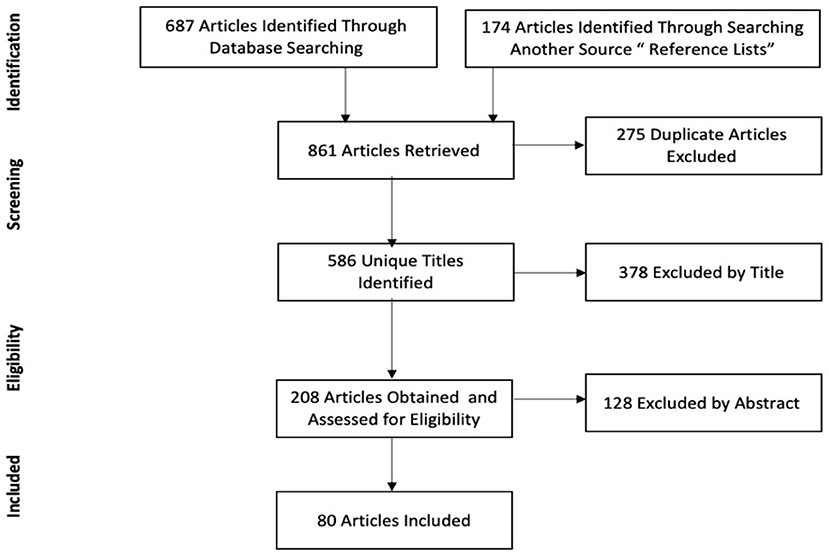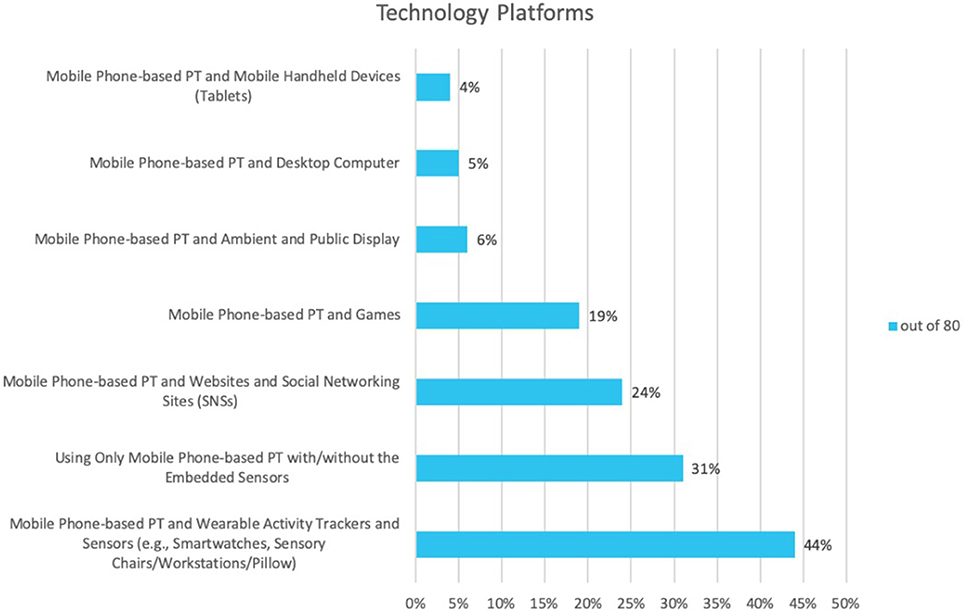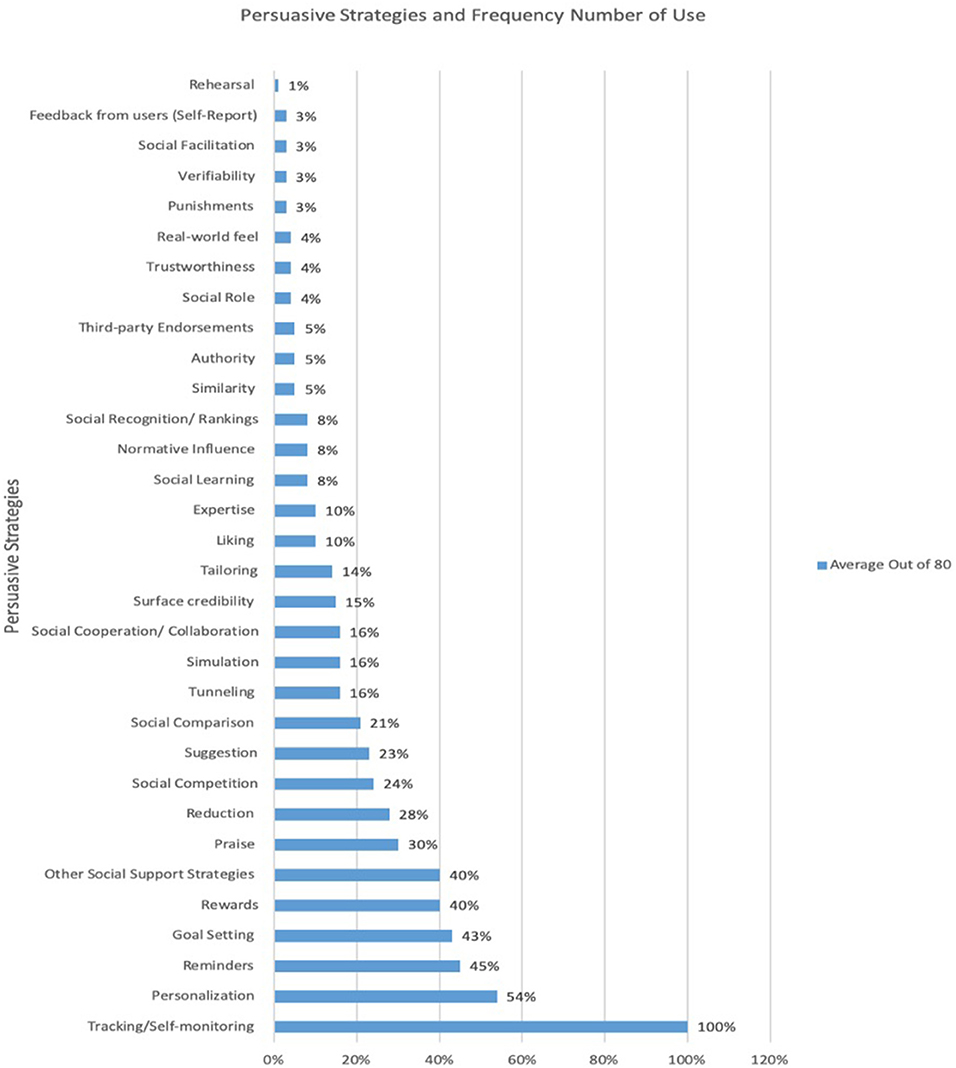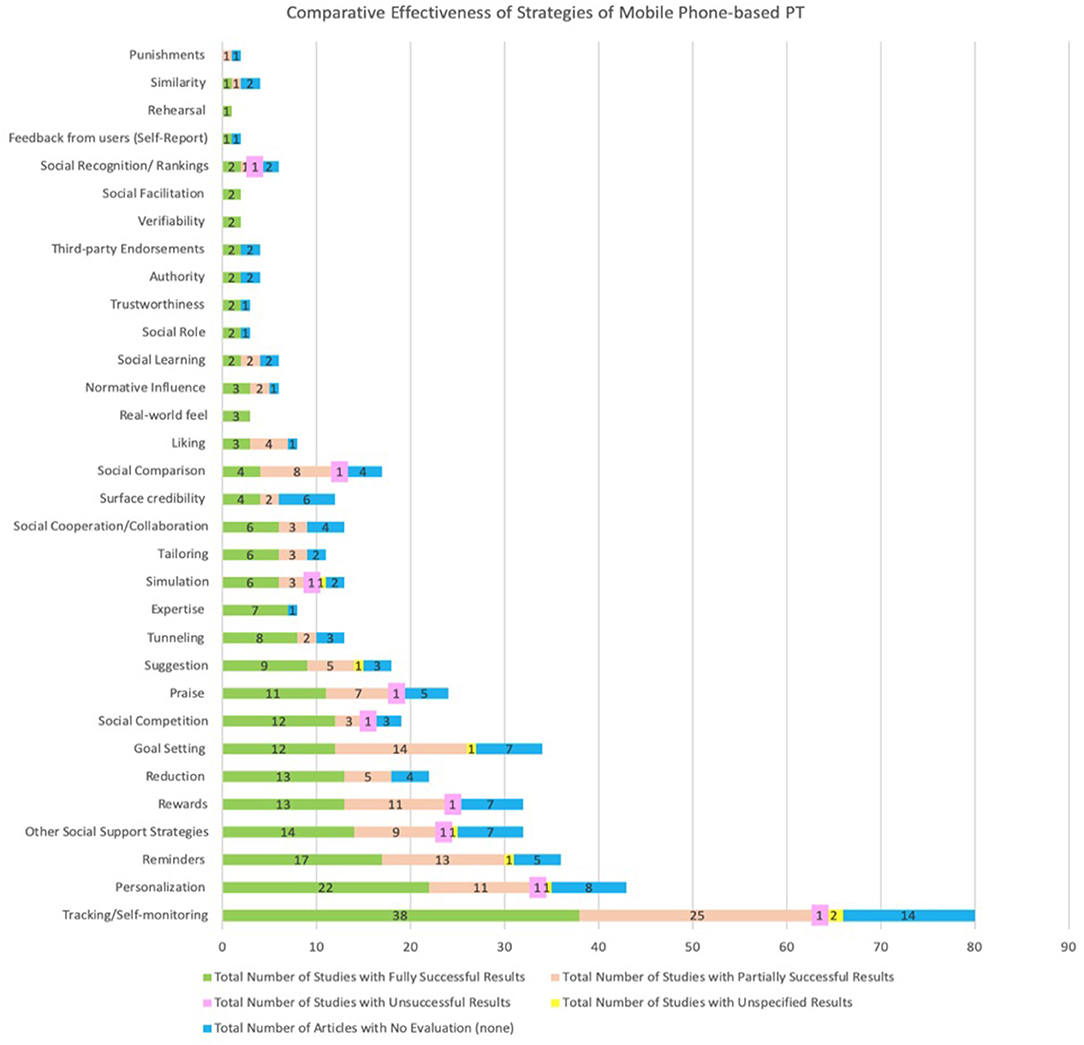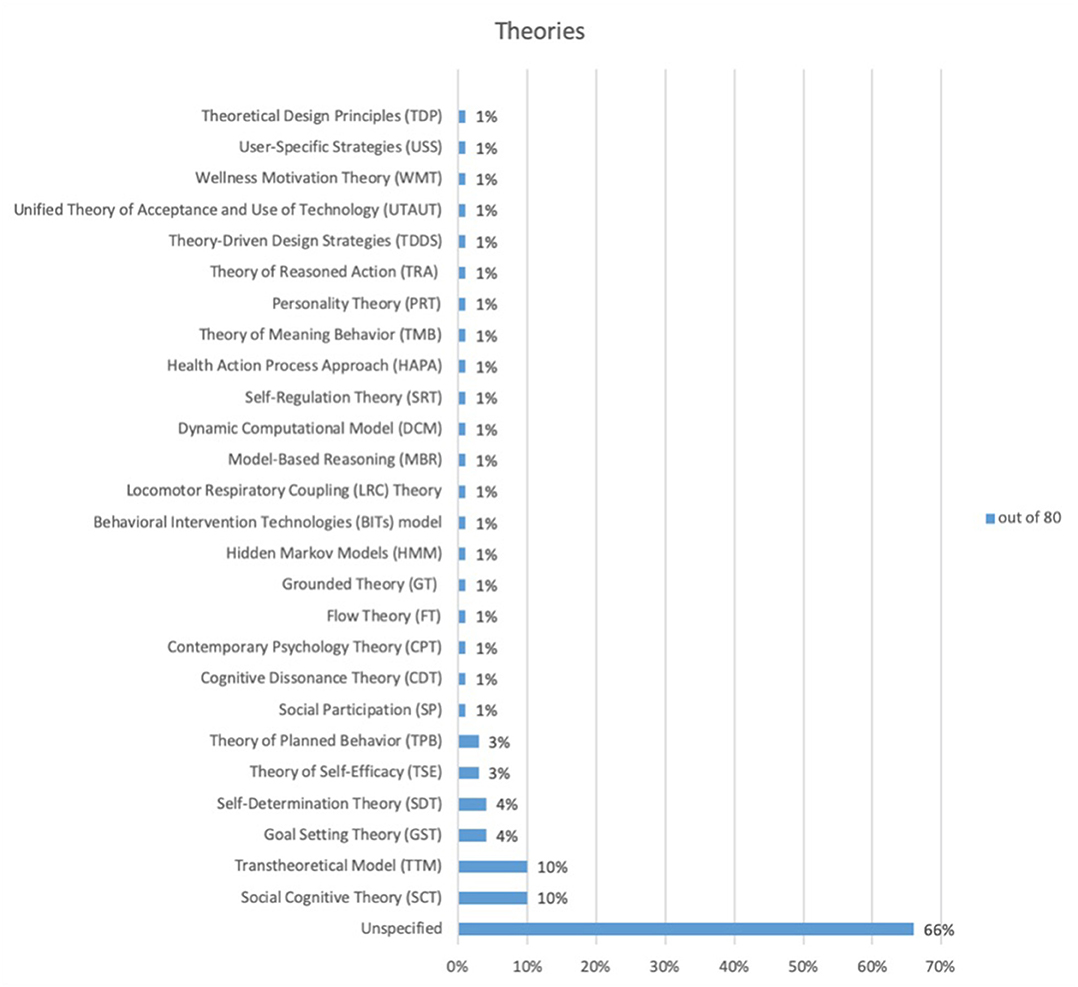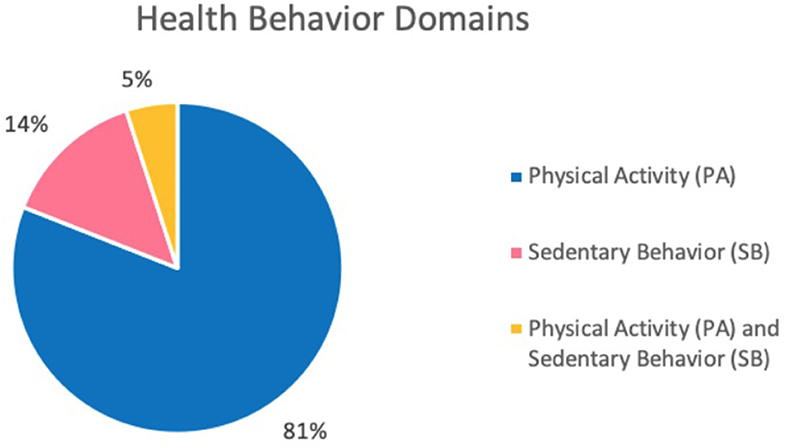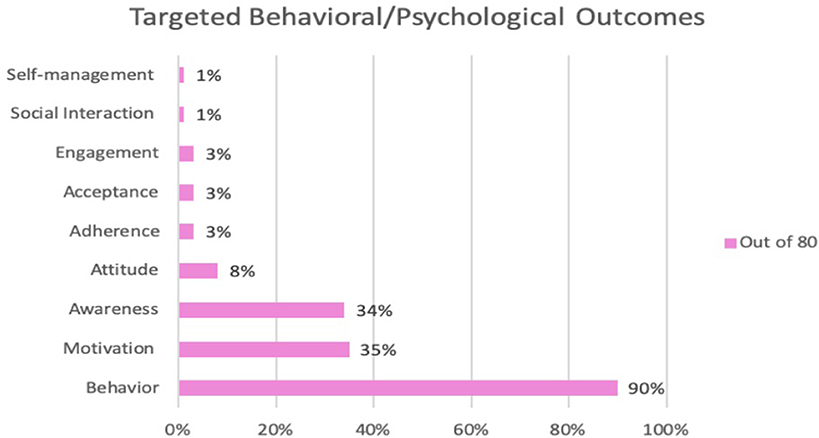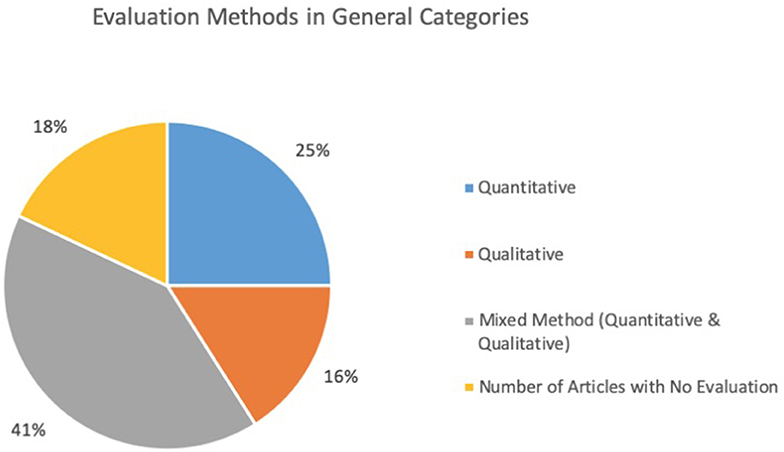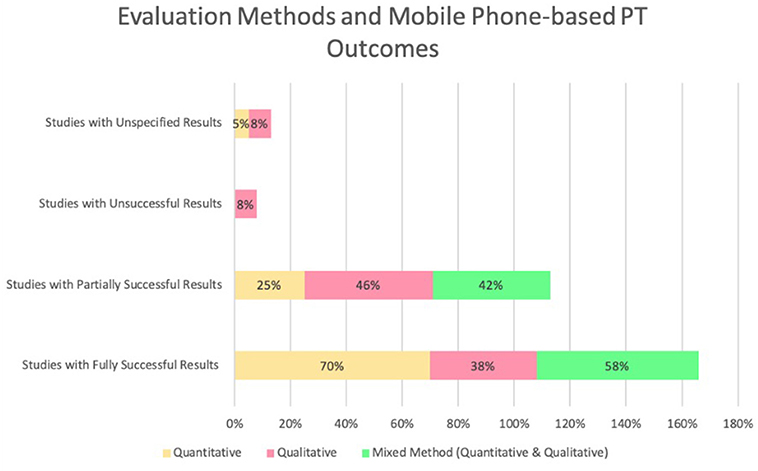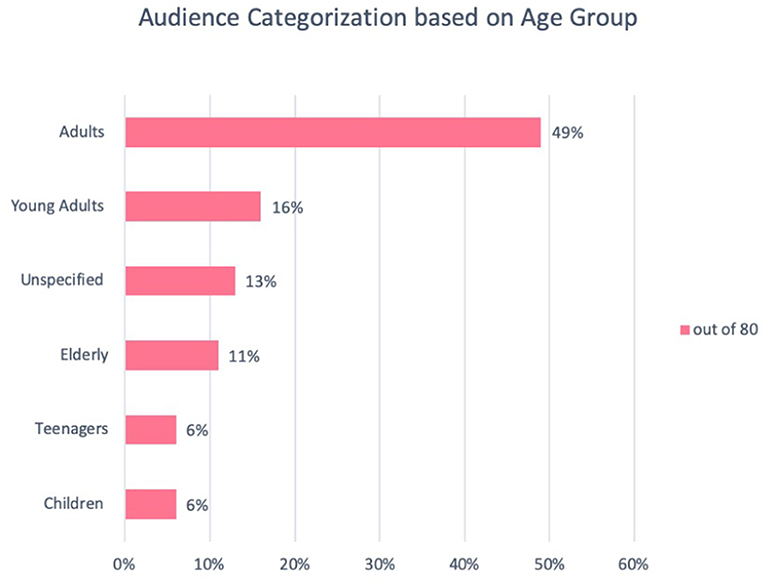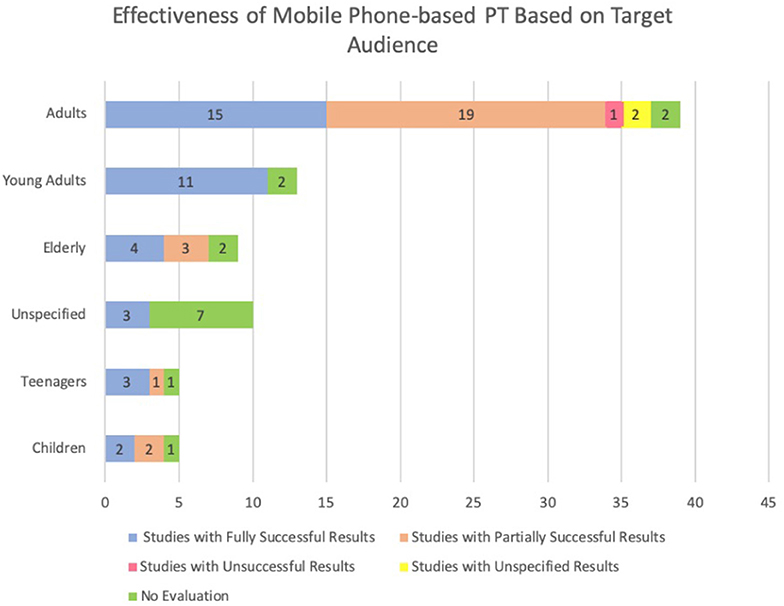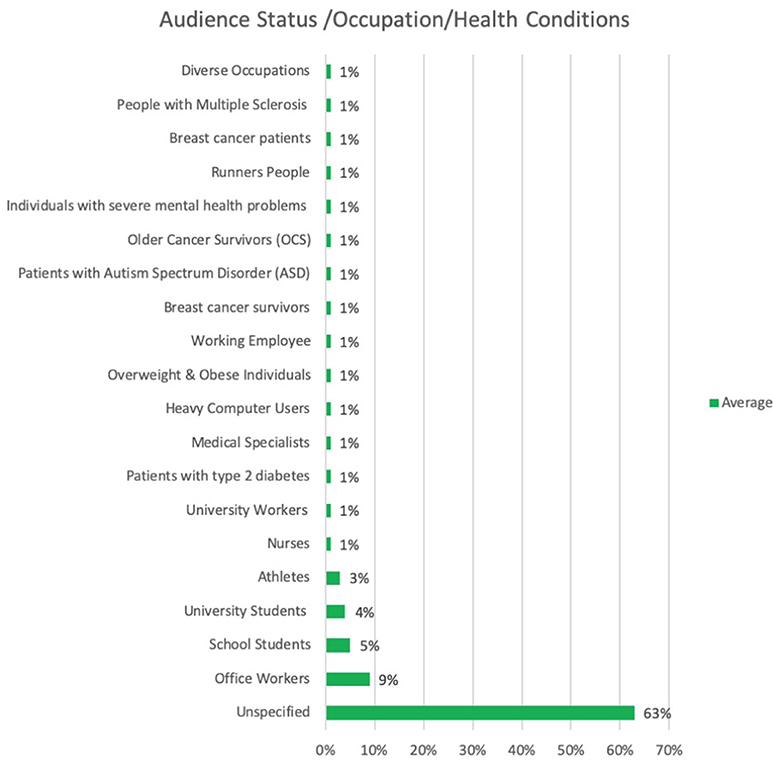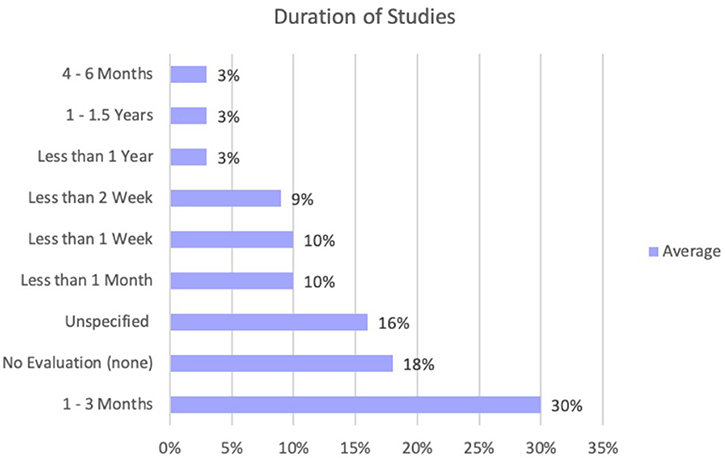- 1Faculty of Computer Science, Dalhousie University, Halifax, NS, Canada
- 2Department of Computer Science, Imam Abdulrahman Bin Faisal University, Dammam, Saudi Arabia
Mobile phone technology has been progressively employed in persuasive technology interventions design to promote physical activity (PA) and discourage sedentary behavior (SB). Because of the ubiquitous nature and seamless integration of mobile phones into user's daily lives, mobile phone-based persuasive technologies (PTs) have the potential to influence and change a user's behavior or attitude continuously. This paper provides a systematic review of 15 years of research (80 papers) focusing on the effectiveness of mobile phone-based PT in promoting PA and reducing SB. Specifically, this review aims to (1) assess the effectiveness of mobile phone-based PT in persuading users to be more physically active and less sedentary, (2) highlight research trends in this area including other technology platforms implemented along with mobile phone-based PT, (3) reveal some strengths and weaknesses of existing mobile phone interventions in PA and SB domains, and (4) provide recommendations to inform future research in this area.
Introduction
The health problems associated with physical inactivity and sedentary behavior are on the rise globally (Ng et al., 2014). Twenty-three percent of adults worldwide do not achieve recommended levels of physical activity (Blair, 2009). For instance, only 35% of the United States population and 40% of the United Kingdom population get a sufficient amount of physical activity (World Health Organization, 2014) on average, as recommended by experts. Consequently, physical inactivity, sedentarism, and unhealthy eating habits have led to the rise of obese and overweight individuals around the world. Moreover, sedentary lifestyle and physical inactivity can increase the likelihood of morbidity and mortality, which have been connected to productivity losses in the employment market. For instance, mortality associated with sedentary behavior led to $13.7 billion of productivity losses worldwide (Murray et al., 2012).
One of the most successful and efficient ways to lower the increasing cost associated with a sedentary lifestyle and overweight is to adopt preventive measures aimed at averting health-related problems and chronic diseases (Abrams et al., 1996; CDC, 2009; Tuso, 2015; Hinney and Hebebrand, 2020). These measures include making people change their sedentary behaviors by adopting an active lifestyle and encouraging them to track and comprehend their health goals, and hence stay physically active. In the digital health domain, persuasive technology (PT) has been considered as a powerful tool to support and encourage behavior change for both individuals and the community in a useful way. PTs are interactive applications, computing devices, or systems that are purposely designed to change, reinforce, or promote desired attitudes and behaviors of an individual by applying persuasive strategies and social influence without coercion or deception (Fogg, 2002). To date, mobile phone technology is the most widely used tool to deliver PTs to promote desirable behavior for individuals, especially in the area of physical activity, to deliver PTs for encouraging physical activity (PA) and discouraging sedentary behavior (SB) (Eapen and Peterson, 2015). This is due to its portable nature that made it to always be with the user and easily integrated into the user's daily life; as a result, they are easily used by individuals in any environment and at any time. In addition, the wireless communication feature (e.g., Bluetooth, Wi-Fi) and tracking (e.g., embedded sensors, GPS, cameras) made mobile phone technology an ideal tool for designing persuasive applications to promote physical activity. Finally, mobile phone technology can easily be integrated with other technology platforms (e.g., games, desktops, tracker devices, ambient displays, websites, and social networks) to achieve a multiplatform PT.
Considering the growing number of mobile-based PT, this paper provides a systematic review of 15 years of research (80 paper) focusing on the effectiveness of mobile phone-based persuasive technology in promoting PA and reducing SB. Specifically, this review aims to (1) assess the effectiveness of mobile phone-based PT in persuading users to be more physically active and less sedentary, (2) highlight research trends in this area including other technology platforms implemented along with mobile phone-based PT, (3) reveal some strengths and weaknesses of existing mobile phone interventions in PA and SB domains, and (4) provide recommendations to inform future research in this area.
Literature Review
Some previous studies evaluated the use of mobile phone-based PT to deliver interventions to increase PA and reduce SB. For example, Bort-Roig et al. (2014) provided a systematic review article to show the ability of smartphones in measuring and influencing PA behavior change. They reviewed 26 articles that were published from 2007 until 2013 and met their inclusion criteria. They found that smartphone technology can measure a range of users' behavior accurately. Furthermore, they emphasized the importance of having more evidence and well-designed studies to assess PA accuracy and long-term duration of study impacts. The review focused mainly on assessing the ability of smartphone technology to measure a range of PA behaviors. Furthermore, Matthews et al. (2016) reviewed the state of mobile applications for health persuasion and behavioral change with an emphasis on PA apps. They used the Persuasive System Design (PSD) model for evaluating the PTs implemented on mobile applications. Their findings showed that primary task, dialogue, and social support principles were the most frequently used in their selected studies, while the credibility support principles were the lowest represented in the design of mobile applications for PA. They suggested that developers and authors should have more knowledge and understanding of the design principles to deliver effective and efficient PTs.
On the other hand, Dunn et al. (2018) reviewed free and paid mobile apps targeting SB on both the iTunes app and Google Play stores based on behavior change techniques (BCTs) adoption. Specifically, they examined 36 free apps and 14 paid apps using a taxonomy of 93 BCTs. The study only focused on SB apps since PA apps have already been examined in previous studies. The findings of the review done by Dunn et al. (2018) showed that SB apps employed fewer behavior change techniques (BCTs) than PA mobile apps and other technology interventions in the domains of PA and healthy eating.
Most existing studies focused on either SB or PA and are based on a segment of mobile phone-based PTs (such as those targeting only smartphones while ignoring traditional cellular phones). Furthermore, many studies did not compare mobile phone-based PT with those used along with other technology platforms (e.g., activity trackers and sensors devices, desktop, websites, social networks, and games) in terms of effectiveness. Therefore, there is still a need to conduct a comprehensive systematic review of the effectiveness of mobile phone-based PT in persuading users to adopt a healthy lifestyle focusing on both PA and decreasing SB. This paper provides a comprehensive overview along with a comparison of the effectiveness of using mobile phone-based PT alone and using mobile phone-based PT along with other technology platforms.
Materials and Methods
This systematic review paper provides a comprehensive overview of the current state of mobile phone-based PT interventions. Thus, it can inform future research and studies in the area of mobile phone-based PT for PA and SB.
We implemented a quantitative content analysis, a method that applies comparison and contrast, and provides taxonomies of data based on different themes and concepts (Riffe et al., 1997; Orji and Moffatt, 2018). We used seven databases to search and select our literature. These databases include PubMed, Springer, Elsevier Scopus, EBSCOHost, Google Scholar, ACM Digital Library, and IEEE Xplore. We searched using various terms and their combinations including: “persuasive technology and physical activity,” “persuasive technology and sedentary behavior,” “persuasive technology and physical activity and sedentary behavior,” “persuasive technology and fitness,” “persuasive technology and exercise,” “exergames or mobile exergames,” “mobile health applications/app and physical activity,” “fitness applications/apps,” “smartphone applications/apps and physical activity,” “smartphone and physical activity,” “smartphone applications/apps and sedentary behavior,” and “smartphone and sedentary behavior.” This ensures wider coverage of mobile phone interventions in PA and SB across disciplines, such as health informatics and human–computer interaction (HCI).
The search outcome revealed 586 unique articles or titles, of which 378 articles were excluded based on titles, while 208 articles were considered relevant. After examining the abstract of all relevant articles, a total of 80 articles were selected for review. We only considered articles that discuss the design of mobile phone-based PT or mobile phone-based PT in conjunction with other technological platforms to promote PA and reduce SB. In addition, articles must be published between 2006 and 2019 and written in English to be included. The search and selection process are summarized in Figure 1.
Analysis and Coding Scheme
We coded the included articles by adapting a coding scheme that was developed and validated by (Orji and Moffatt, 2018). The coding scheme consists of the following taxonomies: the study author(s), year of publication, targeted age group, number of participants, targeted health domain (e.g., PA, SB), technology implemented [e.g., games, desktop, web, social networking sites (SNSs), mobile devices, activity trackers, etc.], duration/length of assessment (e.g., hours, days, weeks, months, and years), behavior theories implemented in the design or evaluation, motivational strategies or techniques, evaluation method (e.g., qualitative, quantitative, and mixed), country/region of a study, targeted behavioral or psychological outcomes (e.g., behavior, attitudes, motivation, awareness, and adherence), target audience, number of participants used in evaluation, and findings/results (whether successful or not). Subsequently, we analyzed the 80 articles using this coding scheme. We extended the coding sheet with an additional taxonomy: the target audience's occupation/status/health condition. Furthermore, we employed the Persuasive System Design (PSD) model (Oinas-Kukkonen and Harjumaa, 2009) in analyzing the persuasive strategies obtained from the reviewed studies. The summary of the coding sheet for the reviewed studies is shown in Appendix 1.
Results
Our analysis of existing mobile phone-based PT interventions for promoting PA and discouraging SB reveals interesting trends and findings. In this section, we present our results under various categories, including trends by year and country, technology platforms used along with a mobile phone, persuasive strategies and motivational affordances, behavior theories employed, study participants and sample size, and the effectiveness of mobile phone-based PT for PA and SB.
Mobile Phone-Based PT for PA and SB by Year and Country
Figure 2 shows that a substantial number of studies on mobile phone-based PT for PA and SB emerged in 2012. There was some year-to-year fluctuation before 2011 and after 2012 and peaked in 2015 with a total of 12 studies. The year 2019 appears to have the fewest number of studies since 2012. This is because our study was conducted in the middle of 2019, while most of the publications for the year are still on the way.
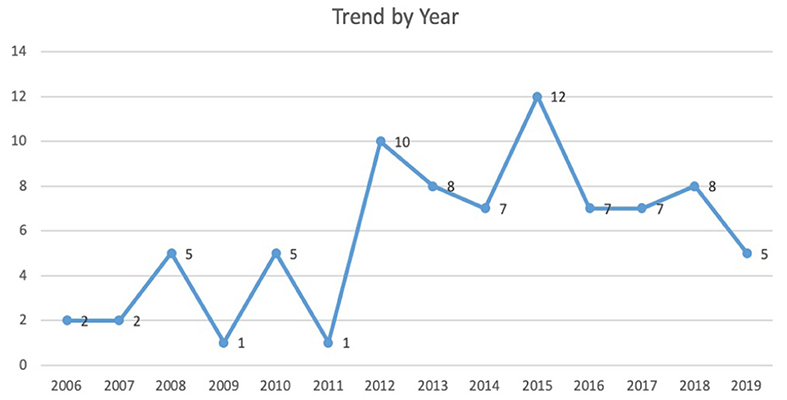
Figure 2. Mobile phone-based persuasive technology (PT) for physical activity (PA) and sedentary behavior (SB) trend by year.
As shown in Figure 3, the studies are from 14 countries, with the United States attaining the highest coverage of 36%, followed by the United Kingdom, Netherlands, and Germany with 10, 9, and 6%, respectively. Belgium, Canada, Italy, Portugal, and South Korea are in the fifth place, having 4% each of all the studies.
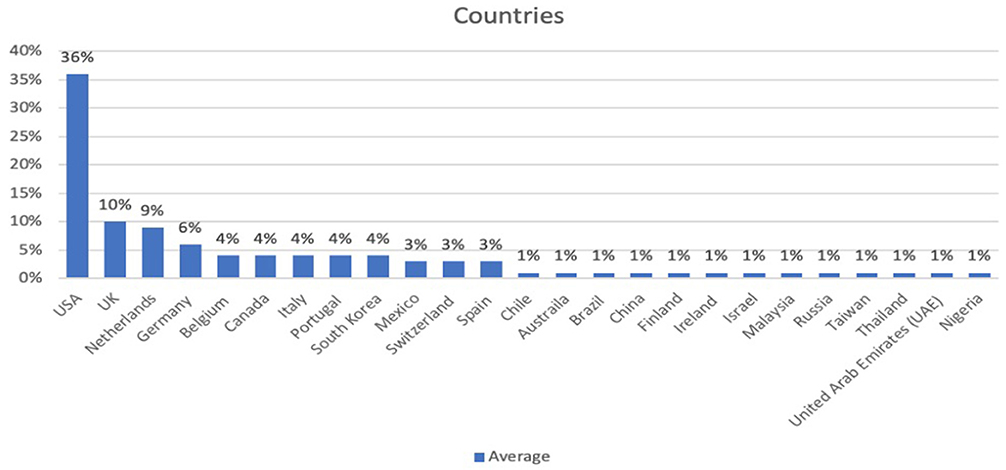
Figure 3. Mobile phone-based persuasive technology (PT) for physical activity (PA) and sedentary behavior (SB) by study country/region.
Evaluation Outcomes of Mobile Phone-Based PT for PA and SB
Figure 4 summarizes the results from the evaluation of mobile phone-based PT for promoting PA and reducing SB reviewed in this paper. Of the 80 relevant articles, 38 (48%) reported fully successful results, and 25 (31%) reported partially successful outcomes (which is a combination of positive and negative results). Fourteen articles (18%) did not evaluate their persuasive system design. Only two studies (3%) did not specify their results, and just one (1%) of all the studies was unsuccessful at attaining its intended persuasion objective.
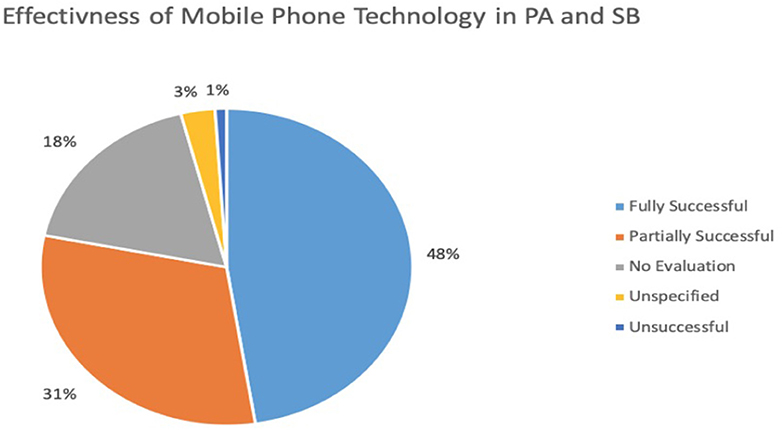
Figure 4. Summary results of mobile phone-based persuasive technology (PT) effectiveness in physical activity (PA) and sedentary behavior (SB).
Major Technology Platforms Employed With Mobile Phone-Based PTs for PA and SB
Figure 5 presents the major technology platforms employed along with mobile phones for persuading users to promote PA and discourage SB. The most frequently employed technology platforms used in conjunction with mobile phone-based PTs are wearable activity trackers and sensors (e.g., smartwatches, accelerometers, pedometers, sensory chairs/workstations/pillows) with a total of 35 studies (44%). This is followed by the use of mobile phone-based PTs alone with/without its embedded (built-in) sensors and cameras with 25 (31%) studies. Mobile phone-based PT in conjunction with websites and social networking sites (SNSs) is in the third place with 19 studies (24%). Mobile phone-based PTs with games ranked fourth with 15 studies (19%). This is followed by mobile phone-based PTs and ambient display, mobile phone-based PTs and desktops, and mobile phone-based PTs and other mobile handheld devices with five studies (6%), four studies (5%), and three studies (4%), respectively.
Figure 6 illustrates the effectiveness of the technology platforms used along with mobile phone-based PTs. Out of 35 studies that used mobile phone-based PTs along with activity trackers and sensors, 16 (46%) reported fully successful outcomes, 13 (37%) were partially successful studies, 2 (6%) did not specify their outcomes, and 4 (11%) did not evaluate their persuasive application. With respect to apps using mobile phone-based PTs alone, out of 25 studies that employed them, 12 (48%) reported fully successful outcomes, 8 (32%) were partially successful, and 5 studies (20%) did not provide evaluations. For mobile phone-based PTs with websites and SNSs, out of 19 studies that implemented them, 9 (47%) were fully successful, 3 (16%) were partially successful, 6 (32%) had no evaluation, and only 1 (5%) was unsuccessful. Out of 15 studies that employed mobile phone-based PTs along with games, 9 (60%) reported fully successful outcomes, 4 (27%) reported partially successful outcomes, 1 (7%) reported no evaluation, and only 1 (7%) was unsuccessful. For mobile phone-based PTs with ambient displays, out of five studies that used them, two (40%) were fully successful, two (40%) were partially successful, and only one (20%) had no evaluation. Out of four studies that employed mobile phone-based PTs along with desktops, three (75%) were fully successful, and only one (25%) was partially successful. Finally, only one study (33%) reported fully successful outcomes and two (67%) partially successful outcomes, out of three studies that employed mobile phone-based PTs along with other mobile handheld devices.
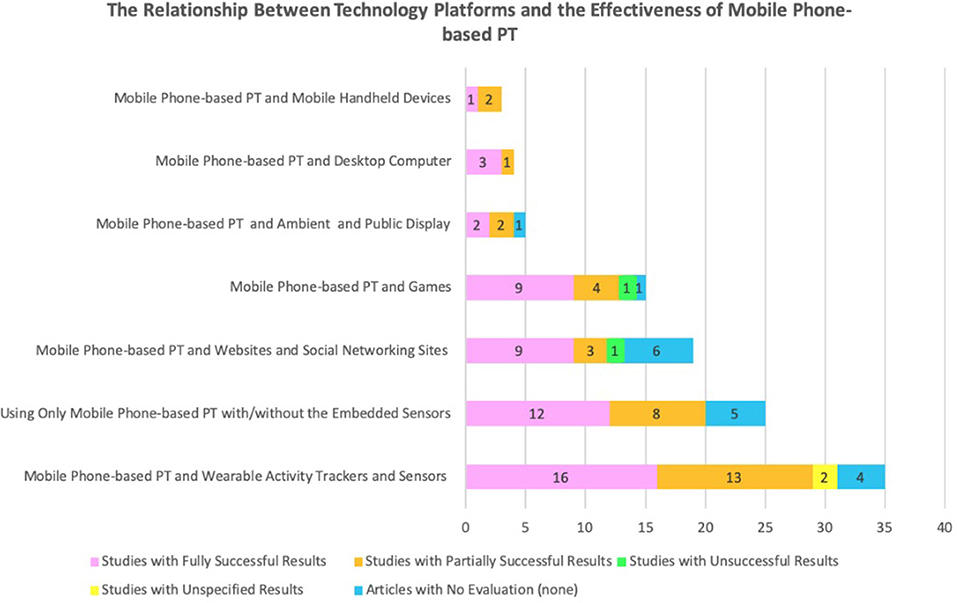
Figure 6. The relationship between technology platforms and effectiveness of mobile phone-based persuasive technologies (PTs).
Persuasive Strategies and Motivational Affordances
Figure 7 shows the persuasive strategies most frequently implemented to bring about desirable behavioral outcomes in the PA and/or SB domains. Tracking and self-monitoring were the most commonly used strategies in all 80 studies (100%). Personalization is the second most implemented strategy in 43 studies (54%). Reminder and goal setting ranked third and fourth most employed strategies with 36 studies (45%) and 34 studies (43%), respectively. Rewards, and other social support strategies (including those that did not explicitly belong to the PSD model such as social tags, likes, invitations, comments, chatting, sharing, etc.), ranked fifth with 32 studies (40%) for each. Praise and reduction ranked sixth and seventh with 24 studies (30%) and 22 studies (28%), respectively. Social competition, suggestion, and social comparison ranked 8th, 9th, and 10th with a total of 19 studies (24%), 18 studies (23%), and 17 studies (21%), respectively. Tunneling, simulation, and social cooperation ranked 11th with 13 studies (16%) for each. The least commonly employed strategies are punishments (negative reinforcements), verifiability, social facilitation, and self-report (feedback from users) with two studies (3%) for each, followed by rehearsal strategy, which was found in only one study (1%).
Comparative Effectiveness of Mobile Phone-Based PTs by Persuasive Strategies
We provide the comparative effectiveness of mobile phone-based PTs based on the persuasive strategies employed in the domains of PA and SB, as shown in Figure 8. We found that some strategies were implemented more commonly, while some strategies were more effective than others. Tracking and self-monitoring strategy was applied in 80 studies (100%), out of which 38 (48%) reported fully successful outcomes, 25 (31%) reported partially successful outcomes, 14 (18%) did not evaluate their application, 2 (3%) did not report their outcomes, and 1 (1%) reported unsuccessful outcome.
Briefly, we identify the top 11 persuasive strategies most effective for promoting PA and reducing SB. As shown in Figure 8, out of the total studies that employed each persuasive strategy (see Persuasive Strategies and Motivational Affordances), tracking and self-monitoring ranked first with a total of 63 (79%) successful outcomes (whether fully or partially successful), followed by personalization that ranked second with 33 (77%) successful outcomes. Reminders came third with 30 (83%) successful outcomes, followed by rewards that ranked fourth with 26 (81%) successful outcomes. Other social support strategies ranked fifth with 23 (72%) successful outcomes, followed by reduction and praise, which ranked sixth with 18 (82%), and 18 (75%) successful outcomes, respectively. In addition, social competition ranked seventh with 15 (79%) successful outcomes. Furthermore, suggestion and social comparison ranked eighth, ninth with 14 (78%), and 12 (71%) successful outcomes, respectively. Tunneling ranked 10th with 10 (77%) successful outcomes, followed by simulation, tailoring, and social cooperation, which ranked 11th with 9 (69%), 9 (82%), and 9 (69%), respectively.
Behavior Theories Employed
As shown in Figure 9, 53 studies (66%) did not employ any behavioral/psychological theory to support their PTs design. The Social Cognitive Theory (SCT) and Transtheoretical Model (TTM) were employed in eight studies (10%). The Goal Setting Theory (GST) and Self-Determination Theory (SDT) ranked third with a total of three studies (4%) for each, followed by the Theory of Self-Efficacy (TSE) and Theory of Planned Behavior (TPB), which came fourth with a total of two studies (3%) for each.
Based on our findings, 27 studies (34%) employed behavior theories to inform their PT designs, while 53 studies (66%) did not employ any theory. Appendix 1 and Figure 10 show that out of the studies that did not employ any theory, there were 40 studies (75%) reported successful outcomes (whether fully or partially successful). Moreover, 12 studies (23%) did not provide any evaluation, while 2 studies (4%) have unspecified outcomes, and only 1 study (2%) were unsuccessful, respectively. Out of the studies that employed behavior theories, 13 (48%) reported successful results, 11 (40%) reported partially successful results, and only 4 (15%) reported unsuccessful outcomes.
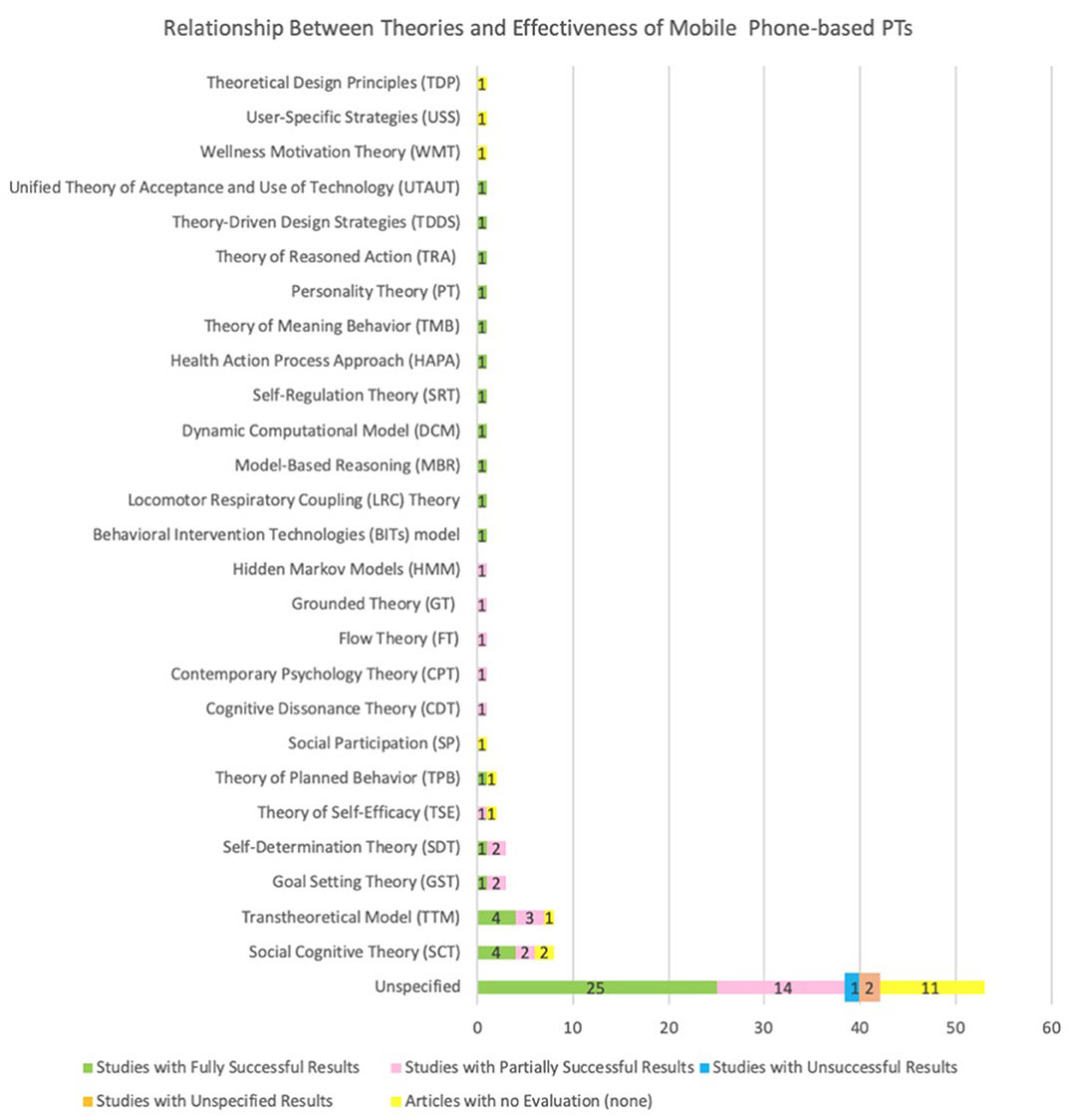
Figure 10. The relationship between behavior theory and the effectiveness of mobile phone-based persuasive technology (PT).
Targeted Health Behavior Domains
In this paper, we searched and selected the articles that targeted PA and/or SB. Figure 11 shows the distribution of the articles across these domains. Sixty-five studies (81%) focused on promoting PA levels, while 11 studies (14%) focused on discouraging SB. Only four studies (5%) aimed to achieve both goals.
Targeted Behavioral and Psychological Outcomes
Figure 12 shows the targeted behavioral and psychological outcomes of the reviewed studies. Nine different outcomes were targeted by the reviewed studies. The most commonly targeted outcome was behavior with a total of 72 studies (90%), followed by motivation with 28 studies (35%). Awareness came third with 27 studies (34%) and attitude fourth with a total of 6 studies (8%). Adherence, acceptance, and engagement were fifth with two studies (3%) for each, while social interaction and self-management were the least targeted outcomes with one study (1%) each.
Study Methodology Used and Outcomes
Figure 13 shows the various evaluation methods employed in the study, and Figure 14 compares the effectiveness of the PT based on the evaluation methods employed. Out of 20 studies (25%) that employed the quantitative approach for evaluating the mobile phone-based PTs, 14 (70%) reported fully successful results, 5 (25%) reported partially successful outcomes, and only 1 (5%) reported unspecified outcomes. A total of 33 (41%) of the studies employed the mix evaluation methods of quantitative and qualitative: a total of 19 (58%) reported fully successful outcomes and 14 (42%) partially successful outcomes. This is followed by studies that employed just the qualitative evaluation approach, with a total of 13 studies (16%) having the least effective outcomes. Out of the studies that employed a qualitative methodology, there were five studies (38%) reporting fully successful outcomes, six studies (46%) reported partially successful outcomes, one study (8%) reported unsuccessful outcomes, and another one study (8%) did not specify its outcomes.
Consequently, the most common evaluation methodology employed was the mixed method (quantitative and qualitative) (41%), followed by a quantitative method (25%), and a qualitative approach (16%) in the third place. The remaining 14 articles (18%) did not evaluate their persuasive systems, as shown in Figure 13.
Study Participants and Sample Size
The number of participants (or sample size) used for the evaluation of mobile phone-based PTs for PA and SB differs considerably in the studies. The total sample size ranges from 4 to 749,010 participants, with the average number of 9,393 for all reviewed studies that evaluated their PTs.
As represented in Figure 15, 39 (49%) of all studies are targeted at adults (31–54 years old), 13 studies (16%) are targeted at young adults (18–30 years old), 10 studies (13%) did not specify their targeted audience, and 9 studies (11%) focused on older people. Teenagers and children are targeted with a total of five studies (6%) for each.
Effectiveness of Mobile Phone-Based PT Based on Target Audience by Age Group
Figure 16 illustrates the effectiveness of implementing mobile phone-based PTs based on the target audience and by age group. Out of 39 studies targeted at adults, 15 (38%) reported successful outcomes, 19 (49%) reported partially successful outcomes, 2 (5%) did not specify their outcomes, 2 (5%) did not evaluate their persuasive designs, and only 1 study (3%) was unsuccessful. Out of 13 studies targeted at young adults, 11 (85%) reported fully successful outcomes, and only 2 studies (15%) did not provide evaluation outcomes. Out of nine studies targeted at the elderly, four (45%) were fully successful, three (33%) were partially successful, and two (22%) have no evaluation. Out of 10 studies that did not specify their target audience, 3 (30%) were fully successful, and 7 (70%) were partially successful. Out of five studies targeted at teenagers, three (60%) reported fully successful outcomes, one (20%) reported partially successful outcomes, and one (20%) did not report evaluation outcome. Out of five studies targeted at children, two (40%) were successful, two (40%) were partially successful, and only one (20%) had no evaluation.
Target Audience by Occupation/Status/Health Condition
Figure 17 illustrates our findings in terms of the general status, occupation, or health condition of the target audience. Fifty studies (63%) of all the reviewed studies did not specify their target audiences' situations. There were seven studies (9%) targeted at office workers, four studies (5%) targeted at school students, three studies (4%) targeted at university students, and only two studies (3%) targeted at athletes. The remaining studies were targeted at a different class of people including people with multiple sclerosis, breast cancer patients, breast cancer survivors, individuals with severe mental health problems, overweight and obese individuals, nurses, medical specialists, and patients with type 2 diabetes, with a total of one study (1%) for each.
Duration of Evaluation
The duration of the studies that evaluated their persuasive system designs ranged from 1 day to around 1.5 years. As shown in Figure 18, 13 studies (16%) did not report the duration of their experiments (i.e., how long it took to assess their mobile phone-based PT design). The findings show that 24 studies (30%) evaluated their designs for between 1 and 3 months, 8 studies (10%) for less than 1 month, 8 studies (10%) for less than 1 week, and 7 studies (9%) for less than 2 weeks. Six studies evaluated their designs for the duration (<1 year, within 1.5 years, and within 4–6 months) with a total of two studies (3%) per duration.
Discussion
This systematic review covers studies that focus on all segments of mobile phone-based PTs (such as those targeting smartphones and traditional cellular phones) for both SB and PA. We provide a comprehensive overview along with a comparison of the effectiveness of using mobile phone-based PT alone and using mobile phone-based PT along with other technology platforms. Our findings from the reviewed studies revealed that mobile phone-based PTs are effective tools for promoting PA and decreasing SB; 79% of reviewed studies reported successful or partially successful outcomes.
Moreover, our findings revealed that implementing mobile phone-based PT along with activity trackers and sensors is the most effective approach with a total of 29 studies (83%) of all the studies in this category reporting successful or partially successful outcomes. The second most effective approach is the use of only mobile phone-based PT along with/without inbuilt (embedded) sensors: 20 (80%) of all the studies in this category reported successful outcomes, whether fully or partially successful. Implementing mobile phones together with games ranked third in terms of their effectiveness: 13 studies (87%) reported successful outcomes, whether fully or partially successful. These results reflect the suitability of mobile phones for deploying persuasive tools, considering its ubiquitous and ever-present nature, coupled with its tracking and monitoring features (such as in-built sensors, GPS, cameras, etc.). These make mobile phones suitable for almost every environment and individuals anytime.
The top 10 most effective strategies (starting from the most effective to the least effective) are tracking/self-monitoring, personalization, goal setting, reminders, other social support strategies, praise and reduction, social competition, suggestion, social comparison, and tunneling and social cooperation. In addition, the majority of the reviewed studies targeted actual behavior change of increasing PA (81%) or decreasing sedentary lifestyle (14%), or both (5%). Others focused on increasing motivation, awareness, and attitudes. Some reviewed articles targeted other behavioral and/or psychological outcomes such as acceptance, adherence, engagement, and social interaction. Similarly, the majority of mobile phone-based PTs encourage and reinforce PA behaviors such as increasing daily step counts, practicing some moderate to vigorous intensity of PA, and frequent standing and stretching to reduce SB. Thus, mobile phone-based PT for increasing PA and decreasing SB has improved over the years and has played an essential role in promoting behavior change practices among users. Furthermore, our analysis involves classifying the persuasive strategies obtained using the PSD model by Oinas-Kukkonen and Harjumaa (2009). However, we found that some strategies were not explicitly mentioned in the PSD model [such as goal setting, punishments (negative reinforcements such as angry facial expressions and losing points), self-report (feedback from users as shown in Young, 2010; Ramanathan et al., 2012), and other social support strategies (e.g., messages, chatting, sharing, invitations, tags, and comments)]. This highlights the need to extend the design model to accommodate some emerging strategies (used in PT design) due to technological advances.
Adults and young adults are the primary users of mobile phones and wearable activity trackers (Simons et al., 2018). This explains why they are the dominant target groups for mobile phone-based PT. Generally, our findings revealed that mobile phone-based PT targeted at adults and young adults are more effective than those targeted at teenagers, children, and older adults. This may be due to the ease of assessing mobile phone-based PT by adults and young adults compared to children and older adults. Another reason may be that adults and young adults can be easily motivated to be more physically active since they are in their active years, thereby making it more likely that mobile phone-based PTs for promoting PA and reducing SB would be more effective and successful. Furthermore, most of the reviewed studies targeted at office workers and students. This is possible because these populations are more likely to have sedentary lifestyles since they sit and work on desks for hours.
Moreover, based on our findings, the majority of the reviewed studies [53 (66%)] did not employ any theory in their mobile phone-based PT designs, while few studies [27 (34%)] employed theories to inform their mobile phone-based PT designs. Therefore, due to the limited number of studies implementing theories, we could not effectively compare the effectiveness of mobile phone-based PT applying behavior theories with those that did not employ any theory. Out of the studies implementing theories, 24 studies (89%) were successful, whether fully or partially. Thus, it appears that employing behavior theories to support mobile phone-based PT improves its effectiveness toward achieving the intended goal of encouraging PA and discouraging SB, which supports previous research done by Orji et al. (2013).
Finally, our findings show the duration of evaluation of the reviewed studies that range from 1 day to 1.5 years. Only 8% of all the studies conducted longitudinal evaluations of their mobile phone-based PT with study duration ranging from 4 months to 1.5 years. Thus, it is hard to determine the long-term effects of the mobile phone-based PT (e.g., mobile phone applications) since the majority of the reviewed studies did not conduct a long-term evaluation of their PT designs.
Limitations of Existing Studies and Recommendations for Future Work
The majority of the reviewed studies employed more than one persuasive strategies, with all implementing the tracking/self-monitoring strategy. Therefore, evaluating the effectiveness of the mobile phone-based PT based on the persuasive strategy employed is complicated. This is even more complicated by the fact that most mobile-based PTs are integrated with other technology platforms such as external sensors. Furthermore, the duration of evaluation of the effectiveness of the mobile phone-based PT is usually short, with 59% of studies ranging from 1 day to 3 months, making it difficult to establish effectiveness over the long term. Thus, future research needs to focus on evaluating effectiveness over long term using a larger target audience. With respect to the demographics of the target populations, the majority of the reviewed studies were targeted at adults and young adults, which makes it difficult to determine the effectiveness of the mobile phone-based PT for other age groups. Thus, future research should target children and older adults, as well.
Moreover, studies that employed theories in their persuasive design tend to be more effective compared to those that did not use any theory. However, the majority of the reviewed studies are not based on any theories. Thus, we suggest that researchers and developers should employ behavior change theories to inform their persuasive designs. We also recommend that they illustrate how the theories employed are linked to the design features.
Finally, based on our findings, the mixed method (i.e., quantitative and qualitative) of evaluation is the dominant method. This is plausible, considering its ability to reveal both quantitative and qualitative outcomes, hence providing richer insight. Thus, we recommend that designers should employ both quantitative and qualitative methods to achieve a comprehensive evaluation of the persuasive systems.
Conclusion
This paper presents a systematic review of the effectiveness of mobile phone-based PT in promoting PA and discouraging SB among the target audience. Based on the analysis of 80 studies, the paper highlights trends in the mobile-based PTs in the domain of PA and SB, including technology platforms implemented along with the mobile phone, the behavior change theories, and the persuasive strategies employed. Finally, based on our findings, we discussed some strengths and weaknesses of existing mobile phone-based PT interventions for motivating PA and discouraging SB, and offered suggestions that inform future research in these areas.
Data Availability Statement
All datasets generated for this study are included in the article/Supplementary Material.
Author Contributions
NA conducted the paper search, the thematic analysis, and wrote the first version of the manuscript. OO and RO contributed to reviewing and refining the manuscript. RO and SS supervised the study.
Conflict of Interest
The authors declare that the research was conducted in the absence of any commercial or financial relationships that could be construed as a potential conflict of interest.
Supplementary Material
The Supplementary Material for this article can be found online at: https://www.frontiersin.org/articles/10.3389/fcomp.2020.00019/full#supplementary-material
References
Abrams, D. B., Orleans, C. T., Niaura, R. S., Goldstein, M. G., Prochaska, J. O., and Velicer, W. (1996). Integrating individual and public health perspectives for treatment of tobacco dependence under managed health care: a combined stepped-care and matching model. Ann Behav Med. 18, 290–304. doi: 10.1007/BF02895291
Blair, S. N. (2009). Physical inactivity: the biggest public health problem of the 21st century. Br. J Sports Med. 43, 1–2. doi: 10.1016/s1440-2440(07)70066-x
Bort-Roig, J., Gilson, N. D., Puig-Ribera, A., Contreras, R. S., and Trost, S. G. (2014). Measuring and influencing physical activity with smartphone technology: a systematic review. Sports Med. 44, 671–686. doi: 10.1007/s40279-014-0142-5
CDC (2009). CDC'S National Center for Chronic Disease Prevention and Health Promotion (2009) The Power of Prevention. Chronic disease the public health challenge of the 21st century. Available online at: https://www.cdc.gov/chronicdisease/pdf/2009-Power-of-Prevention.pdf (accessed July 25, 2019).
Dunn, E. E., Gainforth, H. L., and Robertson-Wilson, J. E. (2018). Behavior change techniques in mobile applications for sedentary behavior. Dig. Health 4:205520761878579. doi: 10.1177/2055207618785798
Eapen, Z. J., and Peterson, E. D. (2015). Can mobile health applications facilitate meaningful behavior change? JAMA 314, 1236–1237. doi: 10.1001/jama.2015.11067
Fogg, B. J. (2002). Persuasive Technology: Using Computers to Change What We Think and Do. Amsterdam: Morgan Kaufmann. doi: 10.1145/764008.763957
Hinney, A., and Hebebrand, J. (2020). Obesity and Overweight. Available online at: https://www.who.int/news-room/fact-sheets/detail/obesity-and-overweight (accessed July 25, 2019)
Matthews, J., Win, T. K., Oinas-Kukkonen, H., and Freeman, M. (2016). Persuasive technology in mobile applications promoting physical activity: a systematic review. J. Med. Syst. 40:72. doi: 10.1007/s10916-015-0425-x
Murray, C. J. L., Vos, T., Lozano, R., Naghavi, M., Flaxman, A. D., Michaud, C., et al. (2012). Disability-adjusted life years (DALYs) for 291 diseases and injuries in 21 regions, 1990-2010: a systematic analysis for the global burden of disease study 2010. Lancet 380, 2197–2223. doi: 10.1016/S0140-67361261689-4
Ng, M., Fleming, T., Robinson, M., Thomson, B., Graetz, N., Margono, C., et al. (2014). Global, regional, and national prevalence of overweight and obesity in children and adults during 1980-2013: a systematic analysis for the global burden of disease study 2013. Lancet 384, 766–781. doi: 10.1016/S0140-67361460460-8
Oinas-Kukkonen, H., and Harjumaa, M. (2009). Persuasive systems design: key issues, process model, and system features. Commun. Assoc. Inform. Syst. 24:96. doi: 10.17705/1CAIS.02428
Orji, R., and Moffatt, K. (2018). Persuasive technology for health and wellness: state-of-the-art and emerging trends. Health Inform. J. 24, 1–26. doi: 10.1177/1460458216650979
Orji, R., Mandryk, R. L., Vassileva, J., and Gerling, K. M. (2013). “Tailoring persuasive health games to gamer type,” in Proceedings of the SIGCHI Conference on Human Factors in Computing Systems - CHI '13 (New York, NY). doi: 10.1145/2470654.2481341
Ramanathan, N., Alquaddoomi, F., Falaki, H., George, D., Hsieh, C. K., Jenkins, J., et al. (2012). “ohmage: an open mobile system for activity and experience sampling,” in 2012 6th International Conference on Pervasive Computing Technologies for Healthcare (PervasiveHealth) and Workshops (San Diego, CA), 203–204. doi: 10.4108/icst.pervasivehealth.2012.248705
Riffe, D., Lacy, S., and Fico, F. G. (1997). Analyzing Media Messages: Using Quantitative Content Analysis in Research. New York, NY: Routledge. doi: 10.2307/358412
Simons, D., De Bourdeaudhuij, I., Clarys, P., De Cocker, K., Vandelanotte, C., and Deforche, B. (2018). A smartphone app to promote an active lifestyle in lower-educated working young adults: development, usability, acceptability, and feasibility study. JMIR Mhealth Uhealth. 6:e44. doi: 10.2196/mhealth.8287
Tuso, P. (2015). Strategies to increase physical activity. Perm. J. 19, 84–88. doi: 10.7812/TPP/14-242
World Health Organization (2014). Global Status Report on Noncommunicable Diseases 2014. World Health Organization.
Keywords: mobile phone, persuasive technology, mobile app, physical activity, sedentary behavior, persuasive strategies, behavioral theories, health
Citation: Aldenaini N, Oyebode O, Orji R and Sampalli S (2020) Mobile Phone-Based Persuasive Technology for Physical Activity and Sedentary Behavior: A Systematic Review. Front. Comput. Sci. 2:19. doi: 10.3389/fcomp.2020.00019
Received: 24 February 2020; Accepted: 22 May 2020;
Published: 24 July 2020.
Edited by:
Victor Zuniga Dourado, Federal University of São Paulo, BrazilReviewed by:
Laszlo Balkanyi, University of Pannonia, HungaryJose Fernando Garcia Estrada, Norwegian University of Science and Technology, Norway
Copyright © 2020 Aldenaini, Oyebode, Orji and Sampalli. This is an open-access article distributed under the terms of the Creative Commons Attribution License (CC BY). The use, distribution or reproduction in other forums is permitted, provided the original author(s) and the copyright owner(s) are credited and that the original publication in this journal is cited, in accordance with accepted academic practice. No use, distribution or reproduction is permitted which does not comply with these terms.
*Correspondence: Noora Aldenaini, bnI0MTI4NjRAZGFsLmNh
 Noora Aldenaini
Noora Aldenaini Oladapo Oyebode
Oladapo Oyebode Rita Orji
Rita Orji Srinivas Sampalli1
Srinivas Sampalli1